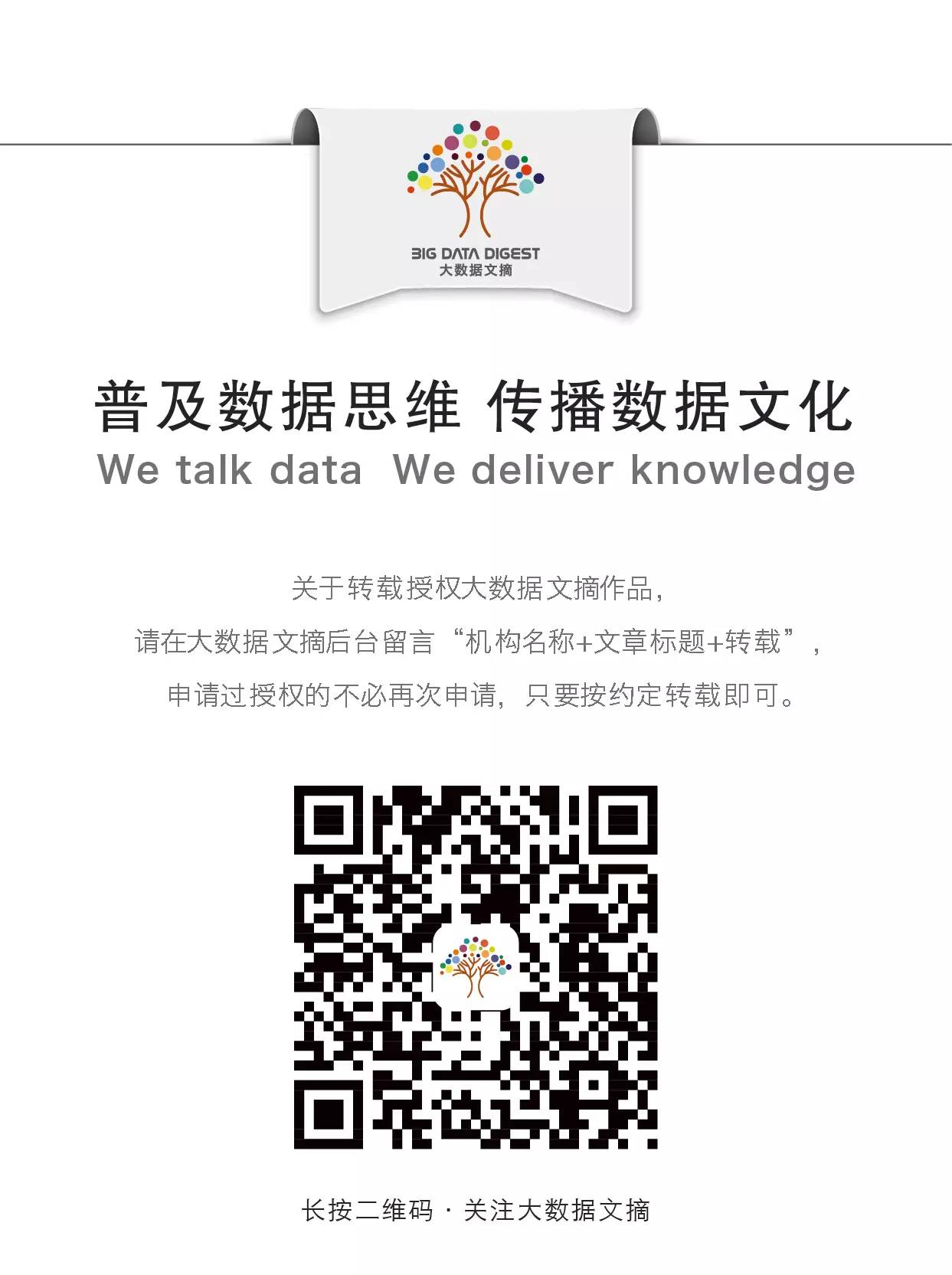
This is a work from Big Data Digest, please contact us for reprints.
Compiled by: Zhang Yuanyuan, Traveler, Aileen
“Introduction: In this issue of the Beginner’s Guide to Data Science, we continue to help you learn Python. This time, our editors have gathered several useful cheat sheets for common Python libraries online, making it easier for you to reference while learning and coding. If the cheat sheet images in the text are unclear, no worries, just reply with “cheat sheet” in the background to download 4 high-definition cheat sheet PDFs!”
As a beginner, I have compiled our previous conversation into the Beginner’s Series “Beginner’s Guide to Data Science: New Year Plan – Let’s Start Learning Python!” The response has been enthusiastic! Now everyone knows how to start learning Python, haha!
Beginner: Yes, yes, I have followed your guidance and completed the basic Python course online, and I have installed Python. But I always forget the basic syntax and rules of Python, sob sob…
Answer: Oh, I see, let me think.
Got it! Do you know what a cheat sheet is? It’s like a summary of subjects that everyone makes before an exam, sometimes the “good students” accidentally bring it into the exam room?
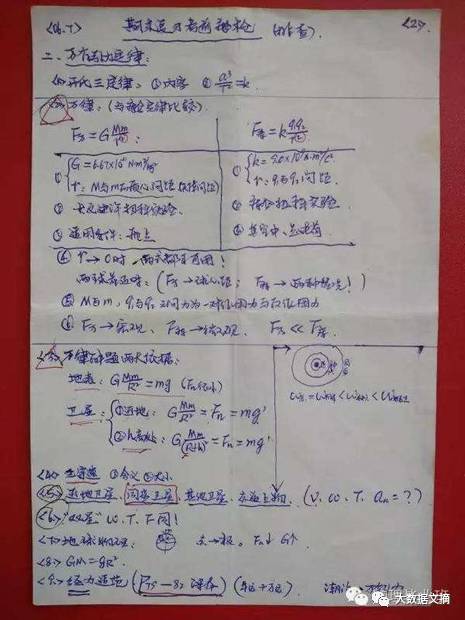
Beginner: Now that you mention it, I do remember my “innocent” exam days. But what does this have to do with Python?
Answer: Of course it relates! I can create a basic Python cheat sheet for you! Here we go~
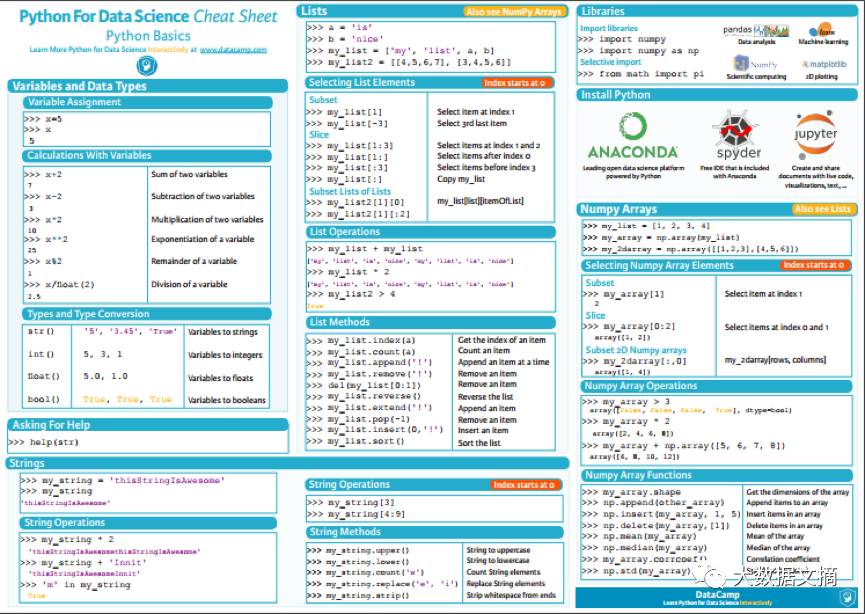
This Python cheat sheet includes relevant introductions to Python: variables, data types, strings, lists, and ultimately covers the basic scientific computing packages in Python.
Beginner: You are so resourceful, this is really timely; I can just refer to this sheet whenever I need to use Python. But I have some confusion lately: everyone says Python is great for big data processing and has many other applications, but after learning the basics, I have no idea how to use Python for these tasks.
Answer: No rush, this is because you are not yet familiar with Python’s powerful and rich libraries. For example, Pandas, which is currently the most popular data analysis package among data scientists.
Beginner: Pandas? Like the animal?
Answer: Oh, it stands for Python Data Analysis Library. It is a data analysis package for Python, based on NumPy (an open-source numerical extension for Python that provides powerful matrix operations, comparable to Matlab).
Beginner: Oh~, I see. It’s a tool that enhances Python’s data analysis capabilities!
Answer: Yes. Pandas was initially developed by AQR Capital Management in April 2008 and was open-sourced at the end of 2009. With the support of NumPy, Pandas has a large number of libraries and standard data models, providing functions and methods for quickly and conveniently processing data, allowing us to efficiently manipulate large datasets with Python, making it a powerful and efficient data analysis environment.
Beginner: Wow, that’s awesome. How should I learn Pandas?
Answer: Well, it’s not too difficult, I can help you! Pandas is designed to make practical data analysis simpler, with fast, flexible, and readable data structures. However, for those who are just starting with Pandas, it may not be easy to master, especially with so many functions and options in this package.
Therefore, a Pandas cheat sheet becomes particularly important! Drumroll~
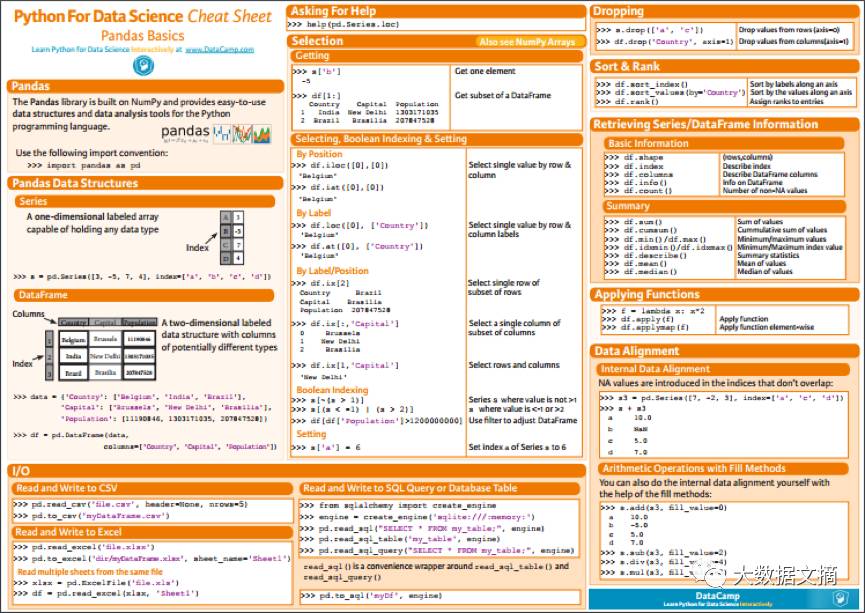
The Pandas cheat sheet will guide you through the basics of the Pandas package: from data structures to input/output, data selection, dropping indices or columns, data organization and sorting, obtaining basic information about data structures, to functional applications of data manipulation, data alignment, etc. This is a must-have manual for beginners!
Beginner: Awesome! So the main Python library is the Pandas package?
Answer: Not just that! There are also Bokeh for visualization and Scikit-Learn for machine learning related to big data.
Beginner: How fascinating! Hurry up and tell me more. Hehe, can I also get a cheat sheet for those?
Answer: You are quite clever! I will organize and provide you with cheat sheets.
Speaking of data analysis, without charts, it’s like a beautiful woman without beautiful clothes, it cannot be appreciated. That’s where Bokeh comes in, this interactive visualization package for Python allows you to achieve high-performance interactive features for large datasets using modern web browsers. Bokeh can quickly create interactive plots, dashboards, and data applications, just like those beauty try-on apps, making your data clearer and more beautifully presented.
Beginner: That’s great! I dread making charts; it’s time-consuming and labor-intensive.
Answer: Haha, it can indeed help you, but Bokeh is not just about making charts. For data scientists, Bokeh is an ideal tool for quickly and easily creating statistical charts. But Bokeh has many more advantages, such as a variety of output options, allowing visualization results to be embedded in applications. Because of the numerous customization options for visualization, Python libraries have become an indispensable member of the data scientist’s toolbox.
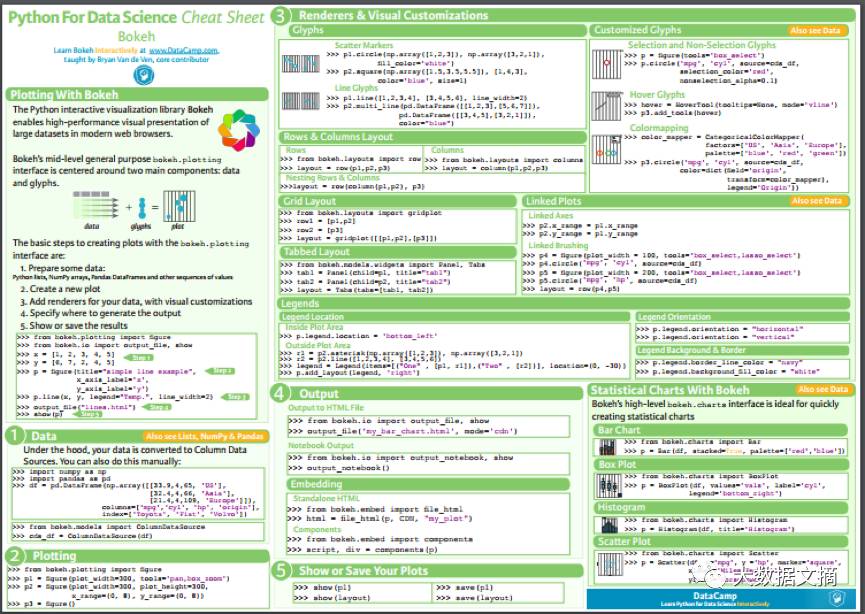
Beginner: Wow, that’s powerful! How do I learn it? Is it complicated?
Answer: Not at all! Don’t forget we have cheat sheets? Look, this cheat sheet not only provides five steps for creating professional charts but also introduces the basics of statistical charts.
With this Bokeh cheat sheet, you will quickly become familiar with the process of creating basic statistical charts: how to prepare data, create charts, add custom visual data renderers, output charts, and save or display them.
Beginner: Hey, got it!
Answer: Wait, there’s still one important member I haven’t mentioned.
Beginner: Oh right, what was it called? Something with learn?
Answer: Scikit-Learn! Most people learning data science with Python have heard of Scikit-Learn. This open-source Python package helps implement various machine learning, preprocessing, cross-validation, and visualization algorithms through a unified interface.
For a newcomer entering the big data field, machine learning and the Scikit-Learn package are essential tools for those aspiring to become data scientists.
Beginner: Yes, I have ambitions! Quickly tell me about the Scikit-Learn cheat sheet!
Answer: Haha, Beginner, at this point, you’ve got it! Take a look, this Scikit-Learn cheat sheet will introduce you to the basic steps for successfully implementing machine learning algorithms: how to load data, how to preprocess data, how to create a model suitable for your data and predict targets, how to validate your model, and how to adjust it to further improve performance.
In short, this cheat sheet will kickstart your data science project: with example code, you can immediately start creating, validating, and adjusting your machine learning models.
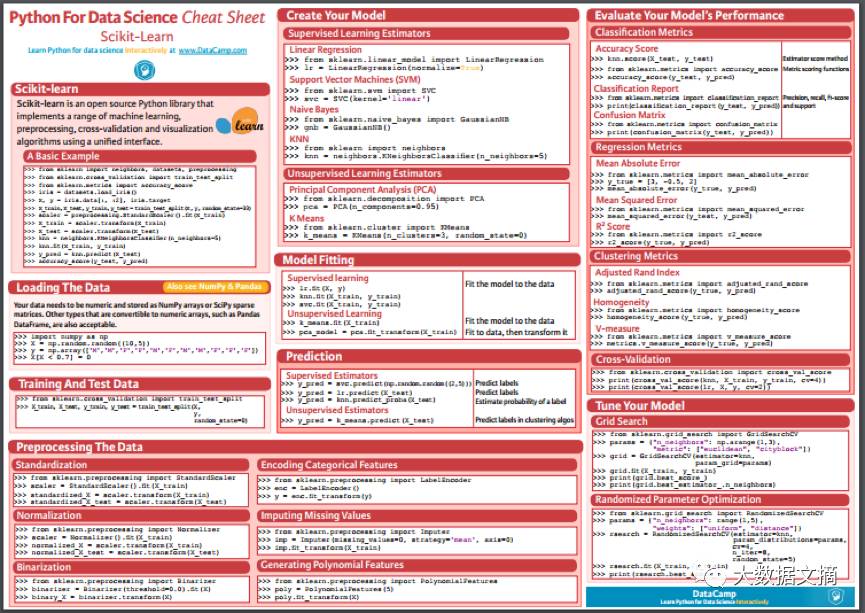
Beginner: Awesome! I totally get it! Python’s capabilities are truly powerful! These cheat sheets have solved my urgent problems. What are we waiting for? New year, new beginnings, let’s start learning now! Let’s go!
Reply with “cheat sheet” in the background to download 4 high-definition cheat sheets and other exciting content!
References:
https://www.datacamp.com/community/tutorials/python-data-science-cheat-sheet-basics#gs.PGKMfHA
https://www.datacamp.com/community/blog/python-pandas-cheat-sheet#gs.PGKMfHA
https://www.datacamp.com/community/blog/bokeh-cheat-sheet-python#gs.PGKMfHA
https://www.datacamp.com/community/blog/scikit-learn-cheat-sheet#gs.0wIIszs
Regarding Reprints
For reprints, please prominently indicate the author and source at the beginning of the article (originally from: Big Data Digest | bigdatadigest), and place a prominent QR code for Big Data Digest at the end of the article. Articles without original identification can be edited according to reprint requirements and can be directly reprinted. After reprinting, please send us the reprint link; for articles with original identification, please send [Article Name - Public Account Name and ID for Authorization] to apply for whitelist authorization. Unauthorized reprints and adaptations will be pursued legally. Contact email: [email protected].
Volunteer Introduction
Reply with “Volunteer” to learn how to join us



Previous Exciting Articles
Click the image to read the article
Beginner’s Guide to Data Science: New Year Plan | Let’s Start Learning Python!

